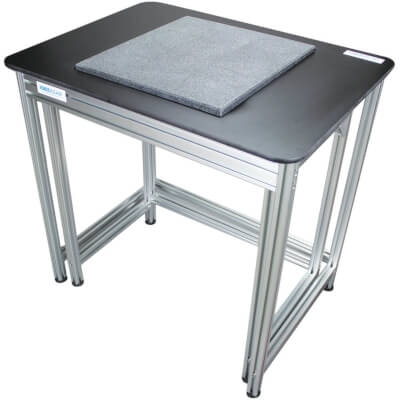
When you’re working with high-accuracy lab equipment like semi-micro and analytical balances, one of the first things you learn is just how sensitive they are to outside forces like vibrations, air currents and even air temperature. To help ensure the integrity of weighing results, these factors must be mitigated. In this blog post, we’ll look at how to address the effects of even the most subtle reverberations with an anti-vibration table.
What is an Anti-Vibration Table?
Vibrations can come from a variety of sources, including machinery, HVAC systems, outside traffic (such as trucks, cars and even trains or subway systems), seismic activity, wind against the building and even footsteps in the lab! Besides not operating your lab near a highway or subway, how do you decrease vibrations when it’s impossible to get away from them?
An anti-vibration table is a table that offers a solid surface that decreases vibrations. Sometimes called weighing or balance tables, they’re typically recommended for use with high-precision, sensitive lab equipment like semi-micro and analytical balances.

How Does an Anti-Vibration Weighing Table Work?
Anti-vibration tables work passively by preventing the transfer of motion between the tabletop and the heavier anti-vibration weighing surface (usually made from a heavy stone like granite or marble). The two surfaces are often separated by rubber mounts that absorb movements and vibrations. The tables typically feature levelling feet to compensate for uneven flooring.
Adam Equipment’s ergonomically designed anti-vibration table, the , is recommended for use with our and ranges of analytical balances. The AVT includes two nested frames: an outer frame for the tabletop that offers an area for users to place samples or notebooks and an inner frame that holds the granite worksurface for the balance. One of the advantages to the two-frame design is that should a lab technician may accidentally jostle the table while working, the balance on the granite worksurface would be unaffected.
To see how to assemble our anti-vibration table, check out the AVT assembly guide on our YouTube channel.
For smaller labs where space is a concern, there are tabletop versions that consist of a small frame that rests upon a lab bench and a large stone that sits atop the frame.
In addition to standard anti-vibration tables, there are also active anti-vibration tables that utilize sensors and actuators to cancel out incoming vibrations.
Other Uses for Anti-Vibration Tables
Semi-micro and analytical balances aren’t the only lab equipment that can benefit from reducing or eliminating vibrations. Anti-vibration tables can be used to set up a calibration station for mass (weighing equipment), temperature (moisture analyzers) and volume (pipettes).

Imaging applications – including sensitive equipment like microscopes – may be disrupted by unwanted movement, causing the sample to shift. Laser and optical systems would also be affected by vibrations, which could cause phase fluctuations and disrupt the laser’s performance.
Questions about anti-vibration tables and how they can benefit your lab? Contact us and our team of experts can help!

